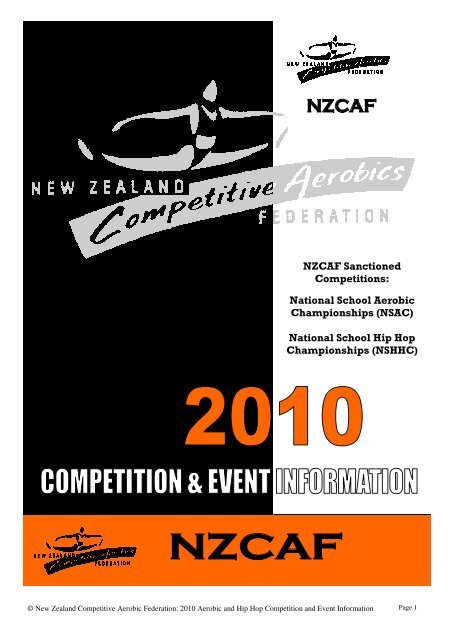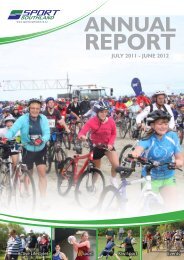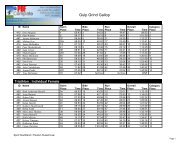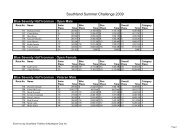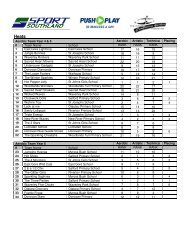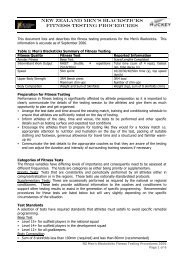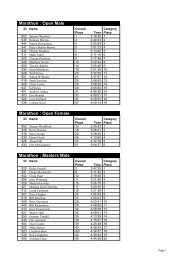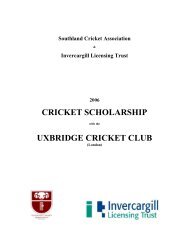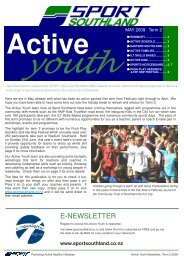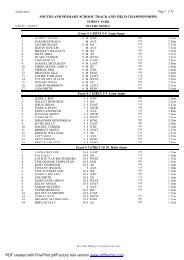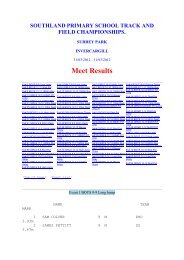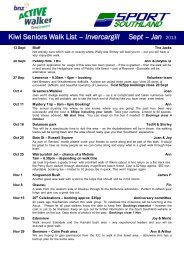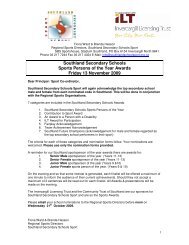NZCAF Sanctioned Competitions: National School ... - Sport Southland
NZCAF Sanctioned Competitions: National School ... - Sport Southland
NZCAF Sanctioned Competitions: National School ... - Sport Southland
You also want an ePaper? Increase the reach of your titles
YUMPU automatically turns print PDFs into web optimized ePapers that Google loves.
<strong>NZCAF</strong> <strong>Sanctioned</strong><br />
<strong>Competitions</strong>:<br />
<strong>National</strong> <strong>School</strong> Aerobic<br />
Championships (NSAC)<br />
<strong>National</strong> <strong>School</strong> Hip Hop<br />
Championships (NSHHC)<br />
© New Zealand Competitive Aerobic Federation: 2010 Aerobic and Hip Hop Competition and Event Information Page 1
CONTENTS<br />
Part 1 GENERAL INFORMATION 3<br />
1.1 New Zealand Competitive Aerobic Federation (<strong>NZCAF</strong>) 3<br />
1.2 <strong>NZCAF</strong> Competition Structure 4<br />
1.3 <strong>NZCAF</strong> Executive Committee 5<br />
1.4 Regional Organisers/Representatives 5<br />
1.5 Event Dates and Venues 5<br />
Part 2 COMPETITION INFORMATION 6<br />
2.1 Categories 6<br />
2.2 Open Events 7<br />
2.3 Section , Division, Year Group, & Grade Overview 7<br />
2.4 Qualifying Regions 8<br />
2.5 Entry Protocol and Criteria 8<br />
Part 3 COMPETITION REQUIREMENTS 9<br />
3.1 Rounds Of Competition 9<br />
3.2 <strong>National</strong> Competition 9<br />
3.3 Official Moves Check 9<br />
3.4 Performance Time 9<br />
3.5 Performance Music 9<br />
3.6 Performance Area 10<br />
3.7 Competition Order 10<br />
3.8 Sponsors Logos 10<br />
3.9 Entering and Leaving The Stage 10<br />
3.10 False Start/Interruption 10<br />
3.11 Medical Attention 10<br />
3.12 Entry Changes or Substitutions 11<br />
3.13 Routine / Music Changes 11<br />
Part 4 AEROBIC TECHNICAL REGULATIONS 12<br />
4.1 Compulsory Moves 12<br />
4.2 Compulsory 32 Count Combination 12<br />
4.3 Skill Moves 13<br />
4.4 Allowable Skill Moves (Static Strength / Push Up /Aerial / Flexibility) 14<br />
4.5 Skill Moves Schedule 17<br />
4.6 Lifts and Supports, Unacceptable and Contraindicated Moves 17<br />
Part 5 SCORING AND JUDGING 18<br />
5.1 Scoring and Ranking 18<br />
5.2 Technical Criteria 19<br />
5.3 Artistic Criteria 19<br />
5.4 Aerobic Criteria 20<br />
Part 6 APPENNDICES 21<br />
6.1 Appendix 1- Description of Skill Moves 21<br />
6.2 Appendix 2 - Description of Contraindicated Moves 27<br />
Part 7 HIP HOP TECHNICAL REGULATIONS 28<br />
7.1 Introduction 28<br />
7.2 General Description of Styles 28<br />
7.3 Scoring Judging and Ranking 31<br />
7.4 Hip Hop Teams Criteria 32<br />
7.5 Acceptable / Unacceptable Moves 33<br />
7.6 Formation Changes, Performance Length 33<br />
© New Zealand Competitive Aerobic Federation: 2010 Aerobic and Hip Hop Competition and Event Information Page 2
PART 1 – GENERAL INFORMATION<br />
These guidelines are designed to assist you when entering a <strong>NZCAF</strong> sanctioned competition in 2010.<br />
These Guidelines supersede any other <strong>NZCAF</strong> Rules and Guidelines.<br />
If at any time you are not sure about anything, please contact any of the event organisers or committee<br />
members listed on page 5. Your query will be directed to the relevant person for answering and if<br />
appropriate a written response provided.<br />
1.1 NEW ZEALAND COMPETITIVE AEROBIC FEDERATION (<strong>NZCAF</strong>)<br />
The <strong>National</strong> <strong>School</strong> Aerobic Championships (NSAC) and the <strong>National</strong> <strong>School</strong> Hip Hop Championships<br />
(NSHHC) are sanctioned by the New Zealand Competitive Aerobic Federation and judged under the<br />
<strong>NZCAF</strong> Technical Regulations. The role of <strong>NZCAF</strong> is to develop and promote the sport of competitive<br />
aerobics and hip hop within New Zealand with membership open to everyone.<br />
1.1.1 MISSION STATEMENT<br />
To encourage participation in sport aerobics and hip hop, especially school age children thereby<br />
promoting physical activity, healthy lifestyle and elevation of self esteem.<br />
<strong>NZCAF</strong> is a non profit organisation whose objective is to ensure sport aerobics and hip hop competitions<br />
are carried out in a planned and efficient way. In particular <strong>NZCAF</strong> will:<br />
1 Serve as the national federation for sport aerobics and hip hop competition in New Zealand and as<br />
a member of the Federation of International <strong>Sport</strong> Aerobics and Fitness (FISAF).<br />
2 Exercise jurisdiction over regional and national activities, and promote international competition.<br />
3 Provide a system of rules and guidelines with which to govern sport aerobics and hip hop at the<br />
regional and national level.<br />
4 Coordinate an annual calendar of regional and national competition events throughout N.Z.<br />
5 Promote and encourage physical fitness, sportsmanship and participation in sports aerobics<br />
and hip hop competitions by supporting the <strong>National</strong> physical activity message of 30 minutes<br />
of moderate physical activity on most days of the week.<br />
6 Disseminate and distribute timely information via website (www.nzcaf.org.nz), newsletters<br />
and flyers to athletes, coaches, managers, administrators, and officials within the sport.<br />
7 Educate, train, and certify judges, coaches and athletes with respect to sport aerobics and hip<br />
hop competition.<br />
8 Work cooperatively with whānau, hapu, iwi and other user groups fulfilling the principles of<br />
Te Tiriti o Waitangi.<br />
9 Select and qualify individuals and teams to represent NZ in international competition.<br />
10 Work with regional organisations, and other user groups to encourage membership<br />
11 Use membership fees ($10 per person per year) to assist competition organisers, to develop<br />
programs for judges, coaches, and athletes; and to provide services for members’ common<br />
benefit.<br />
© New Zealand Competitive Aerobic Federation: 2010 Aerobic and Hip Hop Competition and Event Information Page 3
1.2 <strong>NZCAF</strong> COMPETITION STRUCTURE<br />
NEW ZEALAND COMPETITIVE AEROBIC FEDERATION<br />
<strong>School</strong> Age<br />
Regional Competition<br />
NSAC<br />
NSHHC<br />
FISAF<br />
All Age Divisions<br />
FISAF<br />
<strong>National</strong> <strong>Sport</strong> Aerobic<br />
& Fitness Competition<br />
All Age Divisions<br />
FISAF<br />
<strong>National</strong> Hip Hop<br />
Competition<br />
<strong>School</strong> Age<br />
<strong>National</strong> Competition<br />
NSAC<br />
NSHHC<br />
FISAF<br />
All Age Divisions<br />
FISAF<br />
World <strong>Sport</strong> Aerobic<br />
& Fitness Competition<br />
All Age Divisions<br />
FISAF<br />
World Hip Hop<br />
Competition<br />
NSAC (<strong>National</strong> <strong>School</strong> Aerobic Competition)<br />
NSHHC (<strong>National</strong> <strong>School</strong> Hip Hop Competition)<br />
FISAF (Federation of International <strong>Sport</strong>s Aerobics and Fitness)<br />
© New Zealand Competitive Aerobic Federation: 2010 Aerobic and Hip Hop Competition and Event Information Page 4
1.3 <strong>NZCAF</strong> EXECUTIVE COMMITTEE<br />
<strong>NZCAF</strong> Executive Committee Members<br />
Name Designation Home Mobile Email<br />
Mihi Aston President (06) 8632350 (027) 6245796 mihi@tairawhiti.ac.nz<br />
Jean Shalders Vice President (03) 3529340 (021) 071 333 jshalders@xtra.co.nz<br />
Toni Canny Secretary (03) 2172220 (027) 6003290 tcanny@mail.com<br />
Jo Singer Treasurer (03) 2141975 (027) 2141495 lornejo.s@gmail.com<br />
Meredith Donnelly Executive Member (09) 4100147 (021) 745237 meredithdonnelly@hotmail.com<br />
Tanya Houpt Technical Advisor (04) 2379393 (027) 443293 houpt@xtra.co.nz<br />
1.4 REGIONAL ORGANISERS/REPRESENTATIVES<br />
Regional Organisers/Representatives<br />
Region Representative Home Mobile Email<br />
Gisborne/Eastern Mihi Aston (06) 863350 (027) 6245796 mihi@tairawhiti.ac.nz<br />
<strong>Southland</strong>/Otago Tracy Simpson (03) 211 2150 tracy.simpson@sportsouthland.co.nz<br />
Auckland Meredith Donnelly (09) 4100147 (021) 745 237 meredithdonnelly@hotmail.com<br />
Wellington Tanya Houpt (04) 2379393 (027) 4435293 houpt@xtra.co.nz<br />
Christchurch<br />
Sue Twomey (03) 3324715 (027) 2282308 sue.tim.twomey@xtra.co.nz<br />
Jean Shalders (03) 3529340 (021) 071 333 jshalders@xtra.co.nz<br />
1.5 EVENT DATES & VENUES<br />
Regional/<strong>National</strong>/FISAF Event Dates & Venues<br />
Region Venue Address Date<br />
FISAF Hip Hop Qualifier Lower Hutt Town Hall Wellington May 29<br />
FISAF Aerobic Qualifier St Kentigern College, Pakuranga Auckland June 6<br />
Gisborne/Eastern Gisborne YMCA 150 Roebuck Rd June 27<br />
Auckland Glen Eden Int., Titirangi Kaurilands Rd August 1st<br />
Christchurch Christchurch Girls High <strong>School</strong> August 7<br />
<strong>Southland</strong>/Otago Stadium <strong>Southland</strong>, Invercargill Surrey Park Rd August 7/8<br />
Wellington St Patricks College Town Wellington August 7 - Aerobic<br />
August 8 - HipHop<br />
<strong>National</strong> TBC Wellington September 18-19<br />
© New Zealand Competitive Aerobic Federation: 2010 Aerobic and Hip Hop Competition and Event Information Page 5
PART 2 – COMPETITION INFORMATION<br />
The <strong>National</strong> <strong>School</strong> Aerobic and Hip Hop Championship events are for students who are currently<br />
attending a New Zealand <strong>School</strong> and in Years 4 - 13. Anyone who is 17 years or over (whether attending<br />
a school or not) will be required to compete in the Senior Category under FISAF rules*. FISAF rules are<br />
available from Tanya Houpt (houpt@xtra.co.nz). Please refer www.fisaf.org for more information<br />
2.1 CATEGORIES<br />
© New Zealand Competitive Aerobic Federation: 2010 Aerobic and Hip Hop Competition and Event Information Page 6
2.2 OPEN EVENTS<br />
The <strong>National</strong> <strong>School</strong> Aerobic and Hip Hop Championship events are sanctioned by <strong>NZCAF</strong> as Open Events.<br />
This means competitors from other countries are allowed to compete. Although competitors will<br />
compete in the same category, international competitors are not able to win a New Zealand title.<br />
Separate medals and/or prizes will be presented to international competitors.<br />
2.3 SECTION, DIVISION, YEAR GROUP, & GRADE OVERVIEW<br />
GRADE<br />
Rules Section Division Year Group Grade Novice Open<br />
Novice<br />
Open<br />
NSAC Aerobic Teams (3-6) Primary - Yr 4,5,6 No r r r<br />
Individual Primary - Yr 4, 5, 6 No r r r<br />
Teams 2-4 Intermediate - Yr 7,8 No r r r<br />
Teams 2-4 Secondary - Yr 9-13 Yes b b b<br />
Individual Female Intermediate - Yr 7,8 No r r r<br />
Junior Secondary - Yr 9,10 Yes b b b<br />
Senior Secondary - Yr 11,12,13 Yes b b b<br />
Groups 5-12 Primary/Intermediate - Yr 4-8 No r r r<br />
Groups 5-12 Secondary - Yr 9-13 Yes b r r<br />
Individual Male Intermediate - Yr 7,8 No r r r<br />
Junior Secondary - Yr 9,10 Yes b b b<br />
Senior Secondary - Yr 11,12,13 Yes b b b<br />
NSHHC Hip Hop Teams (4-8)<br />
1. Same Sch.<br />
2. Dance Sch.<br />
1. Same Sch.<br />
2. Dance Sch.<br />
FISAF Cadet Individual<br />
Team<br />
Primary/Intermediate Yr 4-8 No r r r<br />
Jun & Snr Secondary Yr 9-13 No r r r<br />
11,12,13 years of age No r r r<br />
Junior<br />
Senior<br />
Individual<br />
Team<br />
Individual<br />
Team<br />
14,15,16 years of age No r r r<br />
17years or older No r r r<br />
NB: FISAF divisions use FISAF rules without a grade. Individuals may choose to compete under <strong>NZCAF</strong><br />
and FISAF rules. For example, an individual can compete in a team under <strong>NZCAF</strong> rules and as an<br />
individual under FISAF rules. Same <strong>School</strong> division competitors either stay in the Secondary Open Novice<br />
grade OR progress to the Secondary Open grade depending upon their ability.<br />
© New Zealand Competitive Aerobic Federation: 2010 Aerobic and Hip Hop Competition and Event Information Page 7
2.4 QUALIFYING REGIONS<br />
Dunedin / Invercargill<br />
(alternating yearly)<br />
Christchurch<br />
Wellington<br />
Gisborne (Eastern Regions)<br />
Auckland<br />
Timaru South (When competition in Dunedin)<br />
Otherwise which ever is the closest venue<br />
Timaru North<br />
New Plymouth, Central North Island<br />
Tauranga, Rotorua, Whakatane, Opotiki, Hawkes Bay, Taupo, BOP<br />
If you want to compete outside your region, please contact the organiser for the intended region or a<br />
committee member.<br />
2.5 ENTRY PROTOCOL AND CRITERIA<br />
In all NSAC team competition sections and divisions, competitors must be from the same school.<br />
Single sex schools may have team members from the ‘brother’ or ‘sister’ school.<br />
Teams may be any combination of male / female.<br />
Teams will compete in the category of the most experienced member. eg. 1 x open, 2 x novice = Open<br />
Team.<br />
If you are PRIMARY or INTERMEDIATE<br />
Regardless of previous competition experience, it is compulsory to stay within your year group, therefore<br />
for Intermediate competitors you must be in year 7or 8 and for Primary in years 4, 5, or 6.<br />
• You are a NOVICE competitor if you are Year 9 and over and have never competed at any<br />
regional event<br />
• You are an OPEN NOVICE competitor if you are Year 9 and over, have previously competed at<br />
any regional event, and not placed in the top five at a <strong>National</strong> Event in any division.<br />
• You are an OPEN competitor if you are Year 9 and over and placed in the top 5 at any <strong>National</strong><br />
Event, in any division.<br />
• You are a FISAF CADET competitor if you are 11, 12 or 13 years of age<br />
• You are a FISAF JUNIOR competitor if you are 14, 15 or 16 years of age<br />
• You are a FISAF SENIOR competitor if you are 17 years old or over<br />
NB: There are exceptions to the ages when in a FISAF team. Please contact Tanya Houpt<br />
(houpt@xtra.co.nz) if you have any queries regarding this matter.<br />
PLEASE NOTE THE FOLLOWING:<br />
• you must stay in your year group or grade.<br />
• entry fee is $10.00 per person per year incl. <strong>NZCAF</strong> membership fee payable with first entry.<br />
• the Head Judge reserves the right to change the grade of any competitor if deemed necessary<br />
• while there is no limit to the number of times you can enter it is strongly recommended that you<br />
only enter twice, due to the scheduling of your performances. You may enter different Divisions<br />
but you cannot compete in different year groups or grades.<br />
© New Zealand Competitive Aerobic Federation: 2010 Aerobic and Hip Hop Competition and Event Information Page 8
PART 3 – COMPETITION REQUIREMENTS<br />
3.1 ROUNDS OF COMPETITION<br />
NATIONAL AND REGIONAL EVENTS<br />
Where there are 12 or less competitors, there will be two rounds of competition, heats and finals.<br />
Where there are more than 12 competitors in a category, a third round may be held<br />
• Preliminary / Elimination / Grouping all competitors<br />
• Heats: remaining competitors in two groups of ability<br />
• Finals: top 5 competitors<br />
REGIONAL FINALS<br />
At all regional NSAC events, a maximum of 5 in each category will go forward to the Regional Final but<br />
not all will be eligible to compete at the <strong>National</strong> event. See <strong>National</strong> Final Competition directly below:<br />
3.2 NATIONAL COMPETITION<br />
To be eligible to compete at the <strong>National</strong> event, you will have placed as follows, in the final of your<br />
regional event:<br />
1-5 competitors in your category: top 3 to compete at <strong>National</strong> event<br />
6-9 competitors in your category: top 4 to compete at <strong>National</strong> event<br />
10+ competitors in your category: top 5 to compete at <strong>National</strong> event<br />
The Regional Head Judge has the right to allow more to go through to the <strong>National</strong> event if deemed<br />
appropriate.<br />
3.3 OFFICIAL MOVES CHECK<br />
An opportunity to check that any movements or attire are acceptable will be given prior to the first<br />
round of competition. This will be run in year groups and will start with the primary section.<br />
3.4 PERFORMANCE TIMES<br />
Primary Aerobic:<br />
Primary/Intermediate Hip Hop:<br />
Intermediate Aerobic<br />
Secondary Aerobic/Hip Hop:<br />
1minute 30 seconds with 5 seconds either side<br />
1minute 30 seconds with 5 seconds either side<br />
2minutes with 5 seconds either side<br />
2minutes with 5 seconds either side<br />
Timing will begin with the first audible sound and will end with the last audible sound (this would include<br />
a cueing beep if used).<br />
3.5 PERFORMANCE MUSIC<br />
• The responsibility rests solely with the athletes to verify the length of music prior to the<br />
competition.<br />
• Athletes are required to copy their competition music onto a CD.<br />
• The competition music must be the only piece of music on the CD<br />
• All athletes must produce more than one (1) copy in case of theft, loss or damage.<br />
• Music containing ‘bad’ language will not be accepted.<br />
© New Zealand Competitive Aerobic Federation: 2010 Aerobic and Hip Hop Competition and Event Information Page 9
3.6 PERFORMANCE AREA<br />
An area of 7 x 7 metres square will be used for Aerobics and 9 x 9 metres square will be used for Hip Hop<br />
where the venue will allow. If the venue is smaller then the performance area may have to be altered.<br />
Athletes will be given this information as soon as possible.<br />
3.7 COMPETITION ORDER<br />
The order will be randomly drawn by the event organiser and you will be given the order prior to the<br />
competition. Finals order will be the same as heats.<br />
3.8 SPONSORS LOGO’S<br />
Competition outfits may have one space for sponsors name or logo, which must be no bigger than 10cm<br />
by 10cm.<br />
3.9 ENTERING AND LEAVING THE STAGE<br />
After a competitor is introduced they are to enter the performance area and promptly assume their<br />
starting position. The competitor may briefly greet or acknowledge the audience prior to assuming their<br />
starting position and thank or acknowledge the audience before promptly exiting.<br />
3.10 FALSE START/INTERRUPTION<br />
A false start is defined as:<br />
1. A technical problem preventing commencement of a performance after the athlete/s have entered<br />
the stage<br />
2. A technical problem preventing continuation of a performance once it has started<br />
A false start/interruption is when the circumstances causing it are not within the competitor's control.<br />
This would include, but is not limited to, damage to the facility, failure of equipment or foreign objects<br />
on the stage. The decision as to whether the false start/interruption will be acceptable will be at the sole<br />
discretion of the Head Judge.<br />
If it is deemed to be a false start/interruption then the competitor will have the option of performing<br />
immediately or at the end of the category. A routine that is not started or is interrupted, without<br />
completion, due to the fault the athlete, is not considered as a false start/interruption. This would<br />
include but is not limited to, forgetting a routine, falling down from a pair or team starting position. If<br />
not a false start/interruption, the competitor will be disqualified.<br />
3.11 MEDICAL ATTENTION<br />
• A medical professional or official will be on-site in the event of injury or illness. It is the responsibility<br />
of the athlete, coach or team administrator to report an athlete’s injury or illness to the event<br />
organiser(s).<br />
• If at any time prior to or during competition an athlete is ill, injured, or his/her physical condition is at<br />
risk by competing, he/she may be declared ineligible to compete or disqualified from competing<br />
further. The competition organiser(s) reserves the right to withdraw any competitor who appears to<br />
have such serious injury or medical condition.<br />
• Medical apparatus such as casts or plastic or metal joint braces must not be worn during<br />
competition.<br />
• The competition organiser(s) reserves the right to request the submission of a physician’s written<br />
authorisation for an athlete to compete.<br />
© New Zealand Competitive Aerobic Federation: 2010 Aerobic and Hip Hop Competition and Event Information Page 10
3.12 ENTRY CHANGES OR SUBSTITUTIONS<br />
For circumstances beyond control of the athlete(s), changes or substitutions to entries may be made up<br />
to twenty-four (24) hours prior to the heats round. Such circumstances must be submitted in writing and<br />
approved by the competition organiser(s) and /or the Head Judge. (This applies to Team categories<br />
only).<br />
3.13 ROUTINE / MUSIC CHANGES<br />
You may change up to the total of one minute of your routine between regional and national<br />
competition, for the purpose of improvement. However you should keep the same piece of music. In the<br />
case that a piece of music may be unacceptable due to offensive language, the competitor can apply for<br />
permission, from the Head Judge, to replace it.<br />
© New Zealand Competitive Aerobic Federation: 2010 Aerobic and Hip Hop Competition and Event Information Page 11
PART 4 - AEROBIC TECHNICAL REGULATIONS<br />
NATIONAL SCHOOL AEROBIC CHAMPIONSHIP (NSAC)<br />
4.1 COMPULSORY MOVES (The following compulsory moves form the basis of competitive aerobics<br />
which display, technique, strength and flexibility)<br />
NB: Each competitor MUST include in their routine four (4) CONSECUTIVE, STATIONARY and IDENTICAL<br />
repetitions of the following three exercises:<br />
1. Jumping Jacks (Astride Jumps)<br />
2. Alternating High Leg Kicks<br />
3. Push Ups<br />
NB: Teams MUST DO the compulsory moves altogether, in unison and facing the same direction.<br />
1. JUMPING JACKS (ASTRIDE JUMPS)<br />
• 4 in a row with no other exercises in between<br />
• You cannot travel or turn<br />
• You can use different arms<br />
• You must face the front of the stage<br />
• The feet must be identical in spacing and placement for each of the four repetitions<br />
• Feet must open to a minimum of shoulder width apart and feet must close together.<br />
2. ALTERNATING HIGH LEG KICKS<br />
• 4 in a row LRLR or RLRL with no other exercise in between<br />
• You cannot travel or turn<br />
• You must face the side of the stage<br />
• You can use different arms<br />
• The legs should be straight and must kick directly forward being the same height each time<br />
• The supporting heel must be grounded<br />
• You must start and finish each repetition with both feet on the ground with feet together.<br />
3. PUSH UPS<br />
• All competitors year 8 (Intermediate) and under, must perform the compulsory push-ups on their<br />
knees. Both knees must remain on the floor throughout all compulsory repetitions<br />
• Competitors year 9 (Junior Secondary) and over, have the option of doing full push-ups, but the<br />
feet must remain on the floor at all times. One leg or one arm push ups are not allowed<br />
• 4 in a row with no other exercises or rests in between. (i.e. you cannot stop at the top of the<br />
move for a break, it must be continuous, and cannot travel or turn)<br />
• You must start and finish with your arms straight<br />
• Minimum level of flexion (bend) 90 degrees at the elbow joint in either a pectoral/tricep position<br />
• You must face the side of the stage<br />
• Your hands must stay on the floor in the start position all the time and should not move<br />
• You must use the same speed (rhythm) for each repetition.<br />
• Both shoulders should remain square to the floor with the back and neck in alignment<br />
throughout the entire movement.<br />
© New Zealand Competitive Aerobic Federation: 2010 Aerobic and Hip Hop Competition and Event Information Page 12
4.2 COMPULSORY 32 COUNT COMBINATION<br />
NB: This 32 count combination is compulsory for the Primary and Intermediate groups (years 4, 5, 6, 7,<br />
8), and the Novice groups (Junior and Senior Secondary (years 9, 10, 11, 12, 13)<br />
• This combination MUST start within the first 33 counts of the music and be performed in the<br />
order stated for the total of 32 counts. Impact, travel, direction and arm lines of your choice are<br />
encouraged. If you are a pair or a team you MUST DO the compulsory combination altogether, in<br />
unison and facing the same direction. Changing formation is allowed.<br />
• This combination should be HIGH IMPACT<br />
COUNTS MOVEMENTS LEG DESCRIPTION<br />
1 - 4 Step Touch Right, Left<br />
5 - 8 Knee Lift Right, Left<br />
9 - 12 Side Touch Right, Left<br />
13 - 16 *Side Jack (Scissor) Right, Right Starting with two feet together, using the right<br />
leg, hop sideways to the right and extend the<br />
left leg to the side, low to the ground but off<br />
the ground. The left leg then comes together<br />
with the right leg using a hop/jump (side jack).<br />
17 - 20 Step Touch Left, Right<br />
21 - 24 Knee Lift Left, Right<br />
25 - 28 Side Touch Left, Right<br />
29 - 32 *Side Jack (Scissor) Left, Left<br />
1 x side jack = 2 counts<br />
2 x side jacks = 4 counts<br />
NB: A *Side Jack is also known as a ‘Scissor’.<br />
4.3 SKILL MOVES<br />
Competitors SHOULD choose at least one move from each of the four skill groups to aid in balancing the<br />
choreography of a routine. Variations of the skill moves are NOT acceptable unless stated.<br />
NB: There is a limit on the number of skill moves allowable in each category and is dependent on your<br />
year group and grade. These are limited for safety reasons and to encourage a large amount of aerobic<br />
content. The Skills Moves Schedule on page 13, 14 details which year groups and grades can perform<br />
which moves.<br />
© New Zealand Competitive Aerobic Federation: 2010 Aerobic and Hip Hop Competition and Event Information Page 13
4.4 ALLOWABLE SKILL MOVES<br />
GROUP 1 - STATIC STRENGTH SKILL<br />
GROUP 2 - PUSH-UP SKILL<br />
2 Arm Straddle Press 2 Arm Push-Up<br />
2 Arm Pike Press 1arm Push-Up<br />
2 Arm Tuck Press + Variations 2 Arm Tricep Push-Up<br />
2 Arm Side Press 1 Arm Tricep Push-Up<br />
2 Arm Turning Press 180 2 Arm Hinge Push-Up<br />
Wenson Hold (Not Pressed)<br />
Split Planche<br />
2 Arm Circular Push-Up<br />
Split Push-Up<br />
2 Arm Supported Planche Wenson Pressed<br />
V Press Open<br />
1 Or 2 Arm Flying Push-Up<br />
V Press Closed<br />
GROUP 3 - AERIAL SKILL<br />
Front Jete<br />
Straddle Jete<br />
Front Switch Jete<br />
½ Front Switch Jete<br />
Single Pirouette Jump<br />
Tuck Jump<br />
Straddle Jump<br />
Split Jump<br />
Stag Jump<br />
Wolf Jump (Cossack)<br />
Wolf Switch<br />
Air Jack<br />
GROUP 4 - FLEXIBILITY SKILL<br />
Hitch Kick<br />
Hitch And Hold<br />
Standing Fan Kick<br />
Floor Or Standing Splits<br />
Needlepoint<br />
Illusion<br />
Supine Front Splits (Lying On Back)<br />
Supine Fan Kick (Lying On Back)<br />
Straddle Split<br />
Supine Straddle Split (Lying On Back)<br />
Sit Through<br />
Side Lying, Side Split<br />
NB: Using the same skill move twice will count as two moves whether used during or as the start and<br />
finishing pose of the routine.<br />
You may combine, (have more than one in a row), flexibility skill moves together and aerial skill moves<br />
together, but combinations of static strength skill moves or push-up skill moves are NOT acceptable.<br />
This includes combinations between the static strength and push-up groups.<br />
© New Zealand Competitive Aerobic Federation: 2010 Aerobic and Hip Hop Competition and Event Information Page 14
4.5 SKILL MOVES SCHEDULE<br />
SKILL MOVES<br />
COMPULSORY MOVES<br />
PRIMARY<br />
YRS 4, 5, 6<br />
INT.<br />
YRS 7, 8<br />
NOVICE<br />
YRS 9 - 13<br />
O/NOVICE<br />
YRS 9 -13<br />
OPEN<br />
YRS 9 -13<br />
Jacks/Kicks/Push-Ups a a a a a<br />
32 Count Combination a a a X X<br />
STATIC STRENGTH GROUP<br />
Maximum Allowable 2 2 2 3 3<br />
2 Arm Straddle Press a a a a a<br />
2 Arm Pike Press a a a a a<br />
2 Arm Tuck Press /<br />
Variations<br />
a a a a a<br />
2 Arm Side Press a a a a a<br />
2 Arm Turning Press (180) X X X X a<br />
Wenson Hold X X X a a<br />
Split Planche X X X a a<br />
2 Arm Supported Planche X X X X a<br />
V Press Open X X X X a<br />
V Press Closed X X X X a<br />
Combinations Of X X X X X<br />
PUSH UP GROUP (FULL)<br />
Maximum Allowable 2 2 2 3 3<br />
2 Arm Push-Up a a a a a<br />
1 Arm Push-Up X X X X a<br />
2 Arm Triceps Push-Up X a a a a<br />
1 Arm Triceps Push-Up X X X X a<br />
2 Arm Hinge Push-Up X X X a a<br />
2 Arm Circular Push-Up X a a a a<br />
Split Push-Up a a a a a<br />
Wenson Pressed X X X a a<br />
1 Or 2 Arm Flying Push-Up a a a a a<br />
Combinations Of X X X X X<br />
© New Zealand Competitive Aerobic Federation: 2010 Aerobic and Hip Hop Competition and Event Information Page 15
SKILL MOVES SCHEDULE<br />
SKILL MOVES<br />
AERIAL GROUP<br />
PRIMARY<br />
YRS 4, 5, 6<br />
INT.<br />
YRS 7, 8<br />
NOVICE<br />
YRS 9 - 13<br />
O/NOVICE<br />
YRS 9 -13<br />
OPEN<br />
YRS 9 -13<br />
Maximum Allowable 3 3 5 5 6<br />
Front Jete a a a a a<br />
Single Pirouette Jump a a a a a<br />
Straddle Jete X a a a a<br />
Front Switch Jete X a a a a<br />
½ Front Switch Jete a a a a a<br />
Air Jack a a a a a<br />
Tuck Jump a a a a a<br />
Straddle Jump Toe Touch X a a a a<br />
Split Jump X a a a a<br />
Stag Jump a a a a a<br />
Wolf Switch a a a a a<br />
Wolf Jump (Cossack) X a a a a<br />
Combinations Of a a a a a<br />
FLEXIBILITY GROUP<br />
Maximum Allowable 3 3 4 4 4<br />
Hitch Kick a a a a a<br />
Hitch Kick And Hold x x x a a<br />
Standing Fan Kick a a a a a<br />
Standing OR Floor Splits a a a a a<br />
Needlepoint a a a a a<br />
Illusion x x x a a<br />
Supine Front Split (On Back) x a a a a<br />
Supine Fan Kick (On Back) x x x a a<br />
Straddle Split a a a a a<br />
Supine Straddle Split (On<br />
Back)<br />
x a a a a<br />
Sit Through x a a a a<br />
Side Lying, Side Split a a a a a<br />
Combinations Of a a a a a<br />
© New Zealand Competitive Aerobic Federation: 2010 Aerobic and Hip Hop Competition and Event Information Page 16
4.6 LIFTS AND SUPPORTS<br />
Partner/team lifts are only acceptable as a start and finish pose and only if the assisting person or<br />
persons are in a floor position e.g. lying, sitting or kneeling. A body part other than the feet (excluding<br />
the hands) must be in contact with the floor and every supporting person must comply. You are not<br />
allowed to just stand.<br />
Partner supports are allowed during a routine if the assisting person or persons are in a floor position as<br />
mentioned above.<br />
4.6.1 UNACCEPTABLE MOVES FOR NSAC COMPETITION<br />
The following list of moves is considered unsafe and unsuitable for an aerobic competition. Variations of<br />
these moves are also NOT acceptable<br />
Round off<br />
Somersault<br />
Kip<br />
Dive Roll<br />
Bridge Handstand (Hips Over 45)<br />
Standing OR Air Pirouette of More Than 360<br />
Any Dive Roll<br />
Cartwheel<br />
Pommel Horse Moves<br />
Freefalls From Air Or Standing<br />
Drop / Falling Split From Any Position<br />
Flares<br />
Toe Hinge<br />
One Arm/One Leg Push-Up<br />
Floor Turns On Knees<br />
One Arm Presses<br />
Turning Straddle Jumps<br />
4.6.2 CONTRAINDICATED MOVES<br />
The following list of moves is considered unsafe and may cause injury and not be reflective of <strong>Sport</strong>s Aerobics.<br />
Variations of these moves are NOT acceptable<br />
For a full description refer to Appendix 2, page 25.<br />
Straight Leg Sit-Ups<br />
Bicycle and Scissor Kicks on back, supported by the neck<br />
Plough<br />
Windmill<br />
Back Hyperextension<br />
Cole Snap<br />
© New Zealand Competitive Aerobic Federation: 2010 Aerobic and Hip Hop Competition and Event Information Page 17
PART 5 – SCORING AND JUDGING<br />
The judging panel will consist of Technical, Artistic and Aerobic <strong>NZCAF</strong> accredited judges and will include<br />
one Head Judge who does not score.<br />
There are two panel configurations which can be used including:<br />
1. A seven judge panel (3 x Aerobic Judges, 2 x Technical Judges, 2 x Artistic Judges, and 1 x Head Judge)<br />
OR<br />
2. A five judge panel (2 x Aerobic Judges, 1 x Technical Judge, 1 x Artistic Judge, and 1 x Head Judge)<br />
HEAD JUDGE<br />
The Head Judge will oversee the judging panel and is the highest technical authority at a <strong>NZCAF</strong><br />
Competition. The Head Judge does not submit a score but is responsible for ensuring consistent and fair<br />
application of the Technical Regulations by the judging panel and overseeing the correct implementation<br />
of the judging systems and the tabulation of results.<br />
TECHNICAL JUDGE<br />
The Technical Specialist Judge will apply a score for each team, after considering the technical criteria in<br />
comparison to all other routines. The ranking of a routine will be derived from a score out of 10.<br />
ARTISTIC JUDGE<br />
The Artistic Judge will apply a score for each routine, after considering the artistic criteria and in<br />
comparison to all other routines. The ranking of a team will be derived from a score out of 10.<br />
AEROBIC JUDGE<br />
The Aerobic Judge will apply a score for each routine after considering the aerobic criteria and in<br />
comparison to all other routines. The ranking of a team will be derived from a score out of 10. In the<br />
case of a tie, the lead aerobic judges’ ranking will decided the final rank.<br />
5.1 SCORING AND RANKING<br />
The goal of the ranking system is to determine the winner by the majority of placings given by the<br />
judging panel, rather than an addition of scores.<br />
For example using a 7 judge panel:<br />
Competitor A: 4 judges have 1 st place / 3 judges have 2nd place<br />
Competitor B: 3 judges have 1st place / 4 judges have 2nd place<br />
Competitor A is the winner<br />
The tabulation system will find the competitor/team with the most first places then the most second and<br />
third etc, to determine the final ranking.<br />
Application of Scores and Ranks<br />
Each scoring judge will consider their specific criteria to determine a score out of ten (10) points<br />
representing a competitors/team’s performance. From this score a rank for each judge is derived.<br />
The total ranks applied by all judges for each competitor/team, will determine the placing of the teams<br />
for the competition. The competitor/team with the best ranking will be determined the winner.<br />
© New Zealand Competitive Aerobic Federation: 2010 Aerobic and Hip Hop Competition and Event Information Page 18
5.2 TECHNICAL CRITERIA<br />
EXECUTION (Is the main focus)<br />
This is how well you perform every move you have in your routine. Moves should be safe and precise<br />
showing good form, ease of movement, good posture and control. The compulsory exercises, and where<br />
applicable the compulsory 32 combination, will provide the baseline for scoring.<br />
NB: Moves that are unacceptable, contraindicated, or cannot be executed properly will risk a deduction<br />
in ranking as will the exclusion of any of the compulsory elements (refer to Appendix 2 page 24 for a list<br />
of unacceptable and contraindicated moves).<br />
STRENGTH<br />
Your compulsory push ups will give a baseline score which you can increase performing extra push-ups<br />
and or Static Strength moves. Power, which is strength and speed together, can be shown in transitions<br />
and aerial moves. Try to show strength in the upper and lower body as well as right and left sides.<br />
FLEXIBILITY<br />
Your compulsory high leg kicks will give a baseline score which you can increase by doing other flexibility<br />
moves. Try to show a balance of flexibility in a large range of joints, especially the hip.<br />
NB: Teams should be synchronised and will be assessed as a single unit, therefore each member should<br />
exhibit similar strength, flexibility and ability.<br />
TIP: Only use high impact aerobic moves and optional skill moves that you can do really well! Never<br />
sacrifice good form for a difficult move.<br />
5.3 ARTISTIC CRITERIA<br />
CHOREOGRAPHY<br />
This is about creativity, originality, and innovative selection of aerobic movement patterns with<br />
unpredictable sequencing. Arm lines are important and need as much attention as your foot patterns.<br />
Individual style and the use of the whole stage will enhance a score. Teams should utilize each other to<br />
create many formations while staying close together to allow movement as one unit. If you constantly<br />
go out of the 7x7m area you may be penalised – this is for safety reasons.<br />
MUSIC INTERPRETATION<br />
Your routine should fit your piece of music and yours only. Use the natural structure and phrasing of the<br />
music which incorporates highs and lows, rhythms, vocals, instrumentals, pre choruses, choruses and<br />
counter tempos. In the case of teams, it is important to stay in time with the music as well as each other.<br />
Music should be motivating and energetic so we suggest the music speed be no slower than 148 beat per<br />
minute. If your music is outside the required length stated, your score may be reduced, depending upon<br />
the extent.<br />
PRESENTATION<br />
This is about generating excitement, projecting confidence and communicating positive emotions by<br />
using physical gestures and facial expressions throughout the entire performance. Teams should<br />
acknowledge that they have team members and display interaction with each other. Presentation is also<br />
determined by the competitor’s appearance and attire which should be clean and tidy. A score will be<br />
reduced where attire does not meet the following criteria:<br />
© New Zealand Competitive Aerobic Federation: 2010 Aerobic and Hip Hop Competition and Event Information Page 19
• Costumes may be one piece leotards, or a two piece bikini style. Bootleg pants and bikini top or<br />
singlets are also acceptable<br />
• Costumes must not be too brief and must be appropriately concealing<br />
• No body oils or paint. (Anything that can rub off onto the floor must not be used)<br />
• Subtle glitter on face and hair is allowed<br />
• Long hair should be off the face and tied back with no theatrical hair accessories or hats<br />
• Jewellery is not allowed (this excludes small naval studs)<br />
• You must wear adequate body support<br />
• Props are not allowed, eg. gloves, musical instruments, scarves etc<br />
• A good supporting shoe must be worn<br />
• Shorts and T-Shirts may be worn provided they are not ‘form’ concealing (too baggy)<br />
• For maximum points outfits should be styled so the judges can see ‘form’<br />
• Wristbands and unobtrusive strapping is allowed<br />
• G-string leotards can only be worn with coloured tights - not flesh coloured<br />
• The outfit should reflect the sporting nature of competitive aerobics rather than being too<br />
theatrical e.g. skirts, too many sequins, dresses, feathers, tassels etc<br />
• Bike pants or tights must be worn under all leotards or two piece costumes<br />
• You may not discard any item of clothing or accessory during the performance.<br />
5.4 AEROBIC CRITERIA<br />
APPROPRIATE<br />
Ultimately the performance must reflect the ‘aerobic’ basis of <strong>Sport</strong> Aerobics. The majority of the<br />
choreography should be high impact, aerobic content.<br />
INTENSITY<br />
Judges will consider the athletes ability to maintain a high level of intensity by using a large range of<br />
<strong>Sport</strong> Aerobic movements, together with full coverage of the stage area, floor, standing and aerial space.<br />
A cardiovascular effect should be shown throughout the entire routine.<br />
COMPLEXITY<br />
Choreography should show complex patterns in the upper and lower body at the same time. The more<br />
muscles you use at one time will also add to the intensity of a routine. You should show good quality<br />
and speed of leg and arm movements together with the ability to transition smoothly and quickly.<br />
NB: An overall high standard of performance will enhance an aerobic score.<br />
© New Zealand Competitive Aerobic Federation: 2010 Aerobic and Hip Hop Competition and Event Information Page 20
PART 6 – APPENDICES<br />
APPENDIX 1 - DESCRIPTION OF SKILL MOVES<br />
GROUP ONE - STATIC STRENGTH SKILL MOVES<br />
NB: In all static strength moves the body is supported off the floor and the position should be held for 2<br />
counts of the music<br />
1.1 ARM STRADDLE PRESS<br />
A balance, starting from a seated position with the legs on the floor in an open ‘ V ’. Hands can be<br />
between the legs at the front or one in front and one behind – both hands must remain on the floor. The<br />
elbows extend to completely support the body off the floor. At the same time the legs are lifted<br />
horizontally and parallel with the floor (straddle position).<br />
Option:<br />
1.2 2 ARM PIKE PRESS OR L SUPPORT<br />
Turning held position turning through 180 0 (for senior secondary open only)<br />
A balance, starting from a seated position with legs on the floor extended straight out to the front. Feet<br />
are together. Elbows extend to support the body as legs lift horizontally and parallel off the floor.<br />
Option:<br />
1.3 2 ARM TUCK PRESS<br />
A pike press with one leg bent turning held position through to 180 0 (for senior<br />
secondary open only)<br />
A balance, starting in a seated position on the floor with the legs and hips flexed in a tucked position.<br />
Legs are lifted in front of the body and elbows are extended to support the body off the floor<br />
maintaining the tucked position.<br />
Option:<br />
1.4 2 ARM SIDE PRESS<br />
Knees can be parallel to the floor, feet crossed, or both legs can be curled to the<br />
side in the same direction<br />
A balance, starting with arms in a tricep push up position where the hands are under the torso, and<br />
elbows are flexed. Both feet lift off the floor with knees bent and the underneath leg is supported in a<br />
lateral position by one arm on the elbow. Both the knees and feet are in a horizontal, parallel position to<br />
the floor.<br />
Options:<br />
One leg flexed and one straight<br />
Both legs straight<br />
Both legs straight with one arm in-between legs<br />
1.5 2 ARM SUPPORTED PLANCHE<br />
A balance from a modified push up position where both elbows are inverted to the waist and the body’s<br />
weight is taken on flexed elbows and the legs are lifted off the floor. The body and legs are extended in a<br />
horizontal position (i.e. shoulder and hips and feet should be square to the floor and not asymmetrical).<br />
This move can be done with feet apart or together.<br />
1.6 SPLIT PLANCHE<br />
This is the same as the 2 arm supported planche except one leg is extended forward and rests on the<br />
shoulder. The back foot is off the floor.<br />
© New Zealand Competitive Aerobic Federation: 2010 Aerobic and Hip Hop Competition and Event Information Page 21
1.7 WENSON HOLD<br />
A balance hold, starting in a seated position where both hands are on the floor placed shoulder width<br />
apart, with elbows flexed. The legs and feet are lifted up in a straddle position and brought forward to<br />
rest on the shoulders or upper arms to create a horizontal ‘V’ position with the floor. The body is<br />
completely supported off the ground.<br />
1.8 V PRESS<br />
A balance hold, starting in a seated position both legs are extended in the front of the body. The hips are<br />
fully flexed and brought forward in front of the body. Legs and feet are in front of the face in a narrow<br />
‘V’ position (i.e. held apart). Elbows extend as the body is supported off the floor.<br />
Option:<br />
Can be done with legs together = V press closed<br />
© New Zealand Competitive Aerobic Federation: 2010 Aerobic and Hip Hop Competition and Event Information Page 22
2.1 2 ARM PUSH UP<br />
GROUP TWO - PUSH UP SKILL MOVES<br />
Starting position is with the body fully extended in the prone position off the floor. Hands and feet are on<br />
the floor with hands shoulder width apart. Elbows are extended and fingers point forwards. Elbows flex as<br />
chest is lowered to the floor forming a minimum of 90 0 at the elbow joints. Elbows are then extended to<br />
raise body to the starting position. Back/shoulder/hip alignment must remain horizontal throughout the<br />
movement.<br />
Option:<br />
2.2 2 ARM TRICEP PUSH UP<br />
Can be performed with one hand placed forward of the shoulder while the other<br />
remains at the shoulder<br />
As for a 2 Arm push up but the starting position is modified so that the hands are placed on the floor, at<br />
the side of the torso, under the shoulder which keeps the elbows close to the body throughout the<br />
entire movement.<br />
2.3 VARIATIONS ON BASIC 2 ARM PUSH UPS<br />
2.3.1 Circular/Rolling Push Up: A push up where the body perform a circular motion forward or<br />
backward or laterally during the push up movement i.e. forward, down, back up.<br />
2.3.2 Split Push Up: A push up where one leg is brought forward to rest on one shoulder.<br />
2.3.3 Flying Push Up: A push up where one or both hands remains on the floor, and the elbows are<br />
flexed in a standard push up position of 90 0. As the elbows extend the feet are kicked or<br />
propelled to form a low ‘V’ with the legs in the air and land in the push up position. The body and<br />
legs stay parallel to the floor.<br />
2.3.4 Wenson Press: A push up where the weight is completely supported on both hands with both<br />
legs brought forward and supported on the upper arm or preferably the shoulders.<br />
2.4 1 ARM PUSH UP<br />
A push up where the weight is supported on one hand. Starting position is the same as the standard push<br />
up or a tricep push up. The legs and can be wide or close together. One hand is released, the supporting<br />
elbow is flexed to a minimum of 90 0 and the chest is lowered towards the floor. The supporting elbow is<br />
then extended and the body raised to the starting position. Alignment of shoulders/hip/back must be<br />
maintained throughout the movement.<br />
Option:<br />
2.5 VARIATION ON 1 ARM PUSH UP<br />
Can be performed with free arm close to body or in laid out position<br />
2.5.1 1 Arm Triceps Push Up: A one arm push-up in which the supporting arm is held perpendicular<br />
(i.e. at 90 0 to the floor), a push up movement is performed during which the elbow of the<br />
supporting arm is held close to the body.<br />
2.6 2 ARM HINGE PUSH UP<br />
A push up where the shoulders move laterally to one side at the bottom of the movement. If the body<br />
moves to the right then the right elbow will lower to just off the floor. The shoulders then move back to<br />
the centre before returning to the start position.<br />
2.7 VARIATION ON 2 ARM HINGE PUSH UP<br />
2.7.1 2 Arm Tricep Hinge Push Up: The body moves backwards as the elbows lower to just off the floor,<br />
i.e. down, back, forwards and up. The body then moves back to the centre before extending<br />
elbows and returning to the start position (ankles and elbows act as hinges).<br />
Option:<br />
Can be performed with feet together or apart<br />
© New Zealand Competitive Aerobic Federation: 2010 Aerobic and Hip Hop Competition and Event Information Page 23
GROUP THREE - AERIAL SKILL MOVES<br />
NB: The following moves are LEAPS - these are aerial moves which DO travel<br />
3.1 FRONT JETE<br />
Starting in a standing position, leap from one leg to the other where the legs move through a front split<br />
position in the air.<br />
3.2 STRADDLE JETE<br />
Starting in a standing position, a sideways leap from one leg to the other where the legs move through a<br />
straddle (side) split before landing.<br />
3.3 FRONT SWITCH JETE<br />
Starting in a standing position, leap from one leg to the other where the legs move into a front split<br />
position then quickly switch to split the opposite leg leading before landing.<br />
3.4 ½ SWITCH JETE<br />
Starting in a standing position, leap from one leg to the other where the front leg bends as it switches to<br />
the opposite leg leading before landing.<br />
NB: The following moves are JUMPS - these are aerial moves which DO NOT travel<br />
3.4 AIRJACK<br />
Starting in a standing position, jump vertically from two feet. Whilst in the air the legs abduct (lift out to<br />
the side) and return together again before landing with both feet together.<br />
3.5 TUCK JUMP<br />
Starting in a standing position, jump vertically from two feet. The knees lift up to the chest and return<br />
before landing with both feet together.<br />
3.6 STAG JUMP<br />
Starting in a standing position, jump vertically from two feet. The front leg is bent in front and the other<br />
leg is lifted bent behind before landing with both feet together.<br />
3.6 SPLIT JUMP<br />
Staring in a standing position, jump vertically from two feet. The legs quickly lift to a front split position,<br />
parallel to the floor, before landing with both feet together.<br />
3.7 STRADDLE JUMP<br />
Starting in a standing position, jump vertically from two feet. The legs lift to a straddle split position, the<br />
hands reach for the toes before landing with both feet together.<br />
3.8 SINGLE PIROUETTE JUMP<br />
Starting in a standing position, jump vertically from two feet. The body completes a 360° (single) turn in<br />
the air before landing with both feet together.<br />
3.9 WOLF SWITCH<br />
A leap from one leg in which the other leg kicks straight to a 90° hip flexion position then bends to a tuck<br />
position, while the ‘take-off’ leg kicks up to a pike (90° hip flexion) position. The torso flexes forward<br />
toward the straight leg and the landing is on two feet.<br />
3.10 WOLF JUMP (COSSACK)<br />
A pike jump with one leg extended horizontal to the ground, the other leg flexed at the hip (90°) with the<br />
knee bent. Landing and take-off are on two feet simultaneously. Arms and torso flex forward toward<br />
legs. One leg kicks to a horizontal position with knee extended and 90 degrees of hip flexion and the<br />
other leg is in a tuck position<br />
© New Zealand Competitive Aerobic Federation: 2010 Aerobic and Hip Hop Competition and Event Information Page 24
GROUP FOUR - FLEXIBILITY SKILL MOVES<br />
NB: The following moves are DYNAMIC FLEXIBILITY MOVES – which are NOT held and are executed in an<br />
upright body position.<br />
4.1 HITCHKICK<br />
A small leap from one foot to another where the supporting leg momentarily tucks up to the chest prior<br />
to the kick and the non landing leg is kicked straight up to the front of the body.<br />
4.2 HITCH AND HOLD<br />
A small leap from one foot to another where the supporting leg momentarily tucks up to the chest prior<br />
to the kick and the non landing leg is kicked straight up to the front of the body and held up by the<br />
hands.<br />
4.3 STANDING FAN KICK<br />
A kick where one leg is swept in a fan movement crossing in front of the body and continuing to circle<br />
outward to the side. This can also be done with the fan movement circling inward.<br />
4.4 SUPINE FAN<br />
Same as for the standing fan kick, except you are lying on your back.<br />
4.5 NEEDLEPOINT<br />
A split in a standing position on one leg with the other one lifted behind with the body dropped forwards<br />
onto the supporting leg. Support may be given by one or both hands. Minimum angle made by legs in<br />
split should be 160 0 .<br />
4.6 ILLUSION<br />
A split standing on one leg the other leg lifted up behind with the body dropped forward onto the<br />
supporting leg. The whole body rotates through a 180° (or 360°) turn during the movement. Minimum<br />
angle made by legs in split should be 160 0 .<br />
Options:<br />
Both hands give support on the floor<br />
One hand gives support on the floor<br />
Unsupported – no hands<br />
NB: The following are SPLIT MOVES – which are executed on the floor<br />
4.7 FRONT SPLIT<br />
A split with one leg flexed straight forward from the hip and the other extended straight behind in an<br />
upright position.<br />
VARIATIONS OF FRONT SPLIT<br />
4.7.1 Prone Front Split: Front split with body lying on the front leg<br />
4.7.2 Supine Front Split: Front split lying on the back holding the top leg<br />
4.7.3 Side Lying Side Split: A split lying on the side where the top leg is lifted up to the side and<br />
overhead.<br />
4.8 STRADDLE SPLIT<br />
A split, where both legs are in a very wide straddle position seated on the floor and the body is in an<br />
upright position.<br />
© New Zealand Competitive Aerobic Federation: 2010 Aerobic and Hip Hop Competition and Event Information Page 25
VARIATIONS OF STRADDLE SPLIT<br />
4.8.1 Pancake: A straddle split with the chest to the floor between the legs.<br />
4.8.2 Supine Straddle Split: A straddle split lying on the back with the legs open and feet to the floor in<br />
line with the head<br />
4.8.3 Sit Through: Starting in a straddle split on the floor, with the body upright. The chest is lowered<br />
to the floor and the legs are moved in a backward direction to come together. This can also be<br />
done in reverse.<br />
© New Zealand Competitive Aerobic Federation: 2010 Aerobic and Hip Hop Competition and Event Information Page 26
APPENDIX 2 - DESCRIPTION OF CONTRAINDICATED MOVES<br />
NB: The following moves are NOT allowed as they may cause injury:<br />
1.1 STRAIGHT LEG SIT-UPS<br />
From lying on your back, sitting all the way up then going back down again. This can cause a lot of strain<br />
on the spine.<br />
1.2 DOUBLE LEG RAISES, BICYCLE AND SCISSOR KICKS<br />
From lying on your back raising and holding both legs off the floor or crisscrossing or cycling the legs in<br />
this position. This can cause a lot of strain on the spine.<br />
1.3 FULL SQUATS, DEEP KNEE BENDS OR GRAND PLIES<br />
From a standing bending knees to an angle below 90 degrees then returning to standing. This can cause<br />
excessive strain on the knees.<br />
1.4 PLOUGH<br />
From lying on the back position, and feet are raised back over behind the head to balance on the neck<br />
and shoulders. This can cause a lot of strain on the spine.<br />
1.5 SIDE LEG LIFTS<br />
From a hands and knees position, raising and lowering a bent or straight leg to the side of the body. This<br />
can cause a lot of strain on the spine.<br />
1.6 HURDLERS STRETCH<br />
From a seated position with one leg extended forward and the other leg turned out to the side of the<br />
body and flexed at 90 degrees or more can cause a lot of strain on the knee.<br />
1.7 WINDMILL<br />
From a standing position flexing forward at the hips to and rotating, as in touching alternate feet. This<br />
can cause a lot of strain on the spine.<br />
1.8 BACK HYPEREXTENSION<br />
From any position, and where the back is over arched. This can cause a lot of strain on the spine.<br />
1.9 COLESNAP<br />
From a squat standing position a jump backwards landing on the arms with extended elbows and hips<br />
fully flexed, forming an open ’V’ in the air.<br />
© New Zealand Competitive Aerobic Federation: 2010 Aerobic and Hip Hop Competition and Event Information Page 27
PART 7 – HIP HOP REGULATIONS<br />
7.1 INTRODUCTION<br />
NATIONAL SCHOOL HIP HOP CHAMPIONSHIP (NSHC)<br />
Hip Hop culture originated in New York amongst young Hispanic and African American communities<br />
during the late 1960's. Synonymous with rap, scratch music and graffiti art, the style encompasses the<br />
movements of break-dancing and body-popping, and has been internationally recognized since the<br />
1970's.<br />
The 1980's saw the emergence of a new style of hip hop into rap videos, distinguished from original<br />
break dancing styles by its concentration on footwork as opposed to acrobatics. Hereafter, the<br />
emergence of house music saw hip hop re-invent itself again with a broader range of influences and<br />
freer expression.<br />
Old <strong>School</strong> / New <strong>School</strong>, General History<br />
The Old <strong>School</strong> Hip Hop Styles such as Locking, Popping and Break dancing or B-boying emerged from the<br />
USA in the 1970’s, and were a result of improvisational steps and moves from the streets and clubs. Oldschool<br />
music had fast beats which matched the breaking moves.<br />
Music videos of artists such as Bobby Brown, Bell Biv Devoe, Heavy D, and M.C. Hammer proved that a<br />
new way of dance was coming alive and young dancers were ready to explore this new form. New moves<br />
were and are continually being invented by creative and innovative versions and mixing of the Old <strong>School</strong><br />
Styles. Current trends, cultures and disciplines such as Martial Arts, Reggae and Soul Train also had an<br />
effect and resulted in New <strong>School</strong> Hip Hop styles evolving in the late 1980’s. Moves were very simple<br />
with steps such as Running man, Roger Rabbit, and Robocop were popular in this era. These were moves<br />
that everybody could do unlike the Old <strong>School</strong> Styles. However, new school dance in present time is<br />
much more evolved and complex. Many dancers have ‘twisted’ popping or electric boogie and put in<br />
their own moves.<br />
Today, Funk and Hip Hop have many individualized styles but the roots are still in Old <strong>School</strong> Hip Hop and<br />
in New <strong>School</strong> Hip Hop. The blending of music styles and dance moves influenced by many factors which<br />
are then personalized by a choreographer, makes it impossible to define Funk and Hip Hop styles<br />
unambiguously.<br />
7.2 GENERAL DESCRIPTION OF STYLES<br />
GENERAL – LOCKING AND POPPING<br />
Both locking and popping, or ticking, originally came from Los Angeles. Popping was created by street<br />
dance crew Electric Boogaloo. Locking was created by The Lockers. Both locking and popping existed a<br />
long time before breaking was born.<br />
During the breaking era, b-boys started to put popping and locking into their dance. Nowadays, so-called<br />
"Breakdance" consists of breaking, locking, and electric boogie or popping.<br />
LOCKING<br />
The best way to describe the movement of locking would be thus: Imaging the little-figured toys that are<br />
like inside-out puppets on small plastic circular platforms or pedestals, and if you press the bottom of the<br />
platform the figure collapses really fast, then when you let your finger up it goes back into shape?... Well<br />
that's what locking looks like. The body moves out of control then back into control snapping into<br />
position, collapsing then snapping back. Locking is basically American street dance and an example of the<br />
movement is used by Janet Jackson in her Rhythm Nation video. This style is very energetic and is<br />
characterized by very precise and clean moves with difficult co-ordination between the arms and legs. A<br />
party dance – a celebration!<br />
© New Zealand Competitive Aerobic Federation: 2010 Aerobic and Hip Hop Competition and Event Information Page 28
POPPING<br />
The best way to describe the movement of popping would be to imagine a force of energy going through<br />
the body causing it to move like a wave. This style is difficult to manage at the technical level as it<br />
requiring command of isolations, a perfect knowledge of the body, and a good sense of the rhythm with<br />
major use of counter-tempo. The style demands continuous contraction of the muscles to the beat to<br />
give a jerky/snapping effect – a bouncy style.<br />
ELECTRIC BOOGIE<br />
Electric boogie is a style of popping (ticking) but the major difference is that Popping creates a soft wave<br />
whereas Electric Boogie creates more jerky waves with micro wave moves, executed with a high velocity<br />
more difficult than classical popping. The Robot, and the more smooth and controlled movements of<br />
mime are characteristic. Instead of throwing the body in and out of control like locking, or in total<br />
hydraulic control like The Robot, energy is passed through the body popping and snapping elbows,<br />
wrists, necks, hips and just about all the body joints along the way. Electric Boogaloo is more like mime in<br />
the sense that it imitates a live wire of electrical current or rippling river, but it still needs the control of<br />
The Robot to give it style.<br />
BREAKDANCING/B-BOYING<br />
Breaking or b-boying, commonly called breakdancing, is a style of dance that evolved as part of hip-hop<br />
culture among Black and Latino American youths in the South Bronx during the 1970s. It is danced to<br />
both hip-hop and other genres of music that are often remixed to prolong the musical breaks.<br />
Four basic elements form the foundation of breaking. The first is Toprock, a term referring to the upright dancing and shuffles.<br />
The second element is Downrock which refers to footwork dancing performed on the floor. The third element is the Freeze,<br />
the poses that breakers throw into their dance sets to add punctuation to certain beats and end their routines. The fourth<br />
element is the Power Moves. These are the most impressive acrobatic moves normally made up of circular motions where the<br />
dancer will spin on the floor or in the air.<br />
The term breakdancing, though commonly used, is frowned upon by those immersed in hip-hop culture because the term<br />
created by the media to describe what was called breaking or b-boying in the street. The majority of the art form’s pioneers<br />
and most notable practitioners refer to the dance as b-boying.<br />
FUNK<br />
Funk dancing originated on the West coast of the United States, where it developed in the late 60’s as a<br />
reaction to the fusion of Soul and Disco, as well as early R’n’B and Hip Hop music.<br />
It is a highly choreographed dance form, similar to dances seen on commercial video clips. It features a<br />
mixture of sharp and fluid movements, popping & locking and animated expression.<br />
UPROCK<br />
Uprock is a soulful, competitive street dance using the rhythms of Soul, and Funk music. The dance<br />
consists of foot shuffles, spins, turns, freestyle movements, sudden body movements called "jerks" and<br />
hand gestures called "burns". Uprock is said to be mastered with discipline, patience, heart, soul, and<br />
knowledge.<br />
STREETDANCE<br />
Streetdance is very physical and incorporates dance moves from all over the world. Various dance styles<br />
are mixed with a multi-cultural influence and funky tunes. Generally a Streetdance routine can include<br />
locking and popping, street style and funk. Streetdance is a FUSION of styles from the Hip Hop genre.<br />
TUTTING/TETRIS<br />
Tutting or Tetris is a dance style that mimics the angular poses common to ancient Egyptian art.<br />
Whoever coined the term probably imagined that this was how King Tut danced. The style is rapidly<br />
evolving but there are some constant rules that define it. The most important stylistic convention is that<br />
limbs form 90 degree angles.<br />
© New Zealand Competitive Aerobic Federation: 2010 Aerobic and Hip Hop Competition and Event Information Page 29
While this constraint is fundamental, and for the most part is not violated, other aspects of the dance are<br />
in flux. Dancers used to utilize a limited set of static hiero-inspired poses, but they now have begun to<br />
create more complex geometric patterns involving interaction between multiple limbs.<br />
BATTLES<br />
A battle is a freestyle where dancers 'fight' against each other on the dance floor without contact. They<br />
form a circle and take turns trying to show each other up by using either a better style, more complex<br />
combinations, or harder moves.<br />
LIQUID DANCING<br />
Liquid dancing (or liquiding) is a form of gestural dance that sometimes involves pantomime. The term<br />
invokes the word liquid to describe the fluid-like motion of the dancers body and limbs. It is primarily the<br />
dancers arms and hands which are the focus, though more advanced dancers work in a full range of body<br />
movements. Liquid dancing is similar to the styles of popping or locking.<br />
BOOGALOO<br />
A fluid style, that uses every part of the body and involves using angles and smooth movements to make<br />
everything flow together. It often uses rolling of the hips, knees, and the head and is often used as a<br />
transition.<br />
RAGGA<br />
This is a dance style originating (in the late 70’s) from street dance by Afrojamaïcans, Afrocarabians,<br />
which uses music which evolved from classical Reggae with a hip hop influence. The style used is a<br />
combination between hip hop moves, afro moves with latin influences with sensuality. It requires very<br />
good physical condition, as many muscles are involved in the Raggajam, particularly in the lower part of<br />
the body. Correct execution requires good technique.<br />
HOUSE DANCE<br />
House is a group of dance styles primarily danced to house music that have roots in the clubs of Chicago<br />
in the late 70’s and early 80’s. The main styles include Footwork, Jacking and Lofting. Like hip hop dance<br />
it was created by black and latino Americans and is often improvisational in nature. It emphasizes fast<br />
and complex foot oriented steps combined with fluid movements in the torso. House dance incorporates<br />
movements from many other sources such as Capoeira, tap, jazz, bebop, and salsa. It includes a variety<br />
of techniques and sub-styles that include skating, stomping, and shuffling. One of the primary elements<br />
in house dancing is a technique called jacking and involves moving the torso forward and backward in a<br />
rippling motion, as if a wave were passing through it. This movement is repeated and sped up to match<br />
the beat of a song. This technique is the most important movement in house dancing. All footwork in<br />
house dancing is said to initiate from the way the jack moves the center of gravity through space. Other<br />
than footwork, jacking, and lofting, house dance has grown to include other related styles such as vogue,<br />
wacking and hustle.<br />
LYRICAL<br />
It’s a hip hop dance style of LA that combines elements of ballet, modern, and jazz dance techniques. It is<br />
commonly set to popular music with vocals or just instrumental bars. The name lyrical comes from the<br />
word "lyrics" because dancers use the lyrics of a song or instrumental music to inspire them to do certain<br />
movements or show expression. The goal of a lyrical dancer is to use gesture, facial expression, and<br />
controlled movements in order to execute their movements and emotions fully. Besides emotional<br />
connection to music, lyrical dance typically encourages use of articulation, line, weight, and movement<br />
qualities.<br />
© New Zealand Competitive Aerobic Federation: 2010 Aerobic and Hip Hop Competition and Event Information Page 30
There are endless moves and styles, more are listed below:<br />
Animation Bopping Bodydrum Centopede Clowning<br />
Crazy Legs Cobra Dime Stopping Floating/gliding Filmore<br />
Hitting Puppet Robot Saccin Scarecrow<br />
Snaking Spiderman Sticking Strobing Ticking<br />
Classic Jumping Techtonic Vogueing Waving<br />
Melbourne Shuffle Krumping Wacking Hype<br />
, Martial Art styles e.g. Capoeira<br />
7.3 SCORING JUDGING AND RANKING<br />
The judging panel will have members who have either an extensive dance background or are currently<br />
involved in Hip Hop (teaching, presenting, judging, choreographing etc.)<br />
There are two panel configurations which can be used including:<br />
1. A five judge panel (4 x hip hop judges and 1 x Head Judge)<br />
OR<br />
2. A three judge panel (2 x hip hop judges and 1 x Head Judge)<br />
Head Judge<br />
The Head Judge will oversee the judging panel and is the highest technical authority at a <strong>NZCAF</strong><br />
Competition. The Head Judge does not submit a score but is responsible for ensuring consistent and fair<br />
application of the Technical Regulations by the judging panel and overseeing the correct implementation<br />
of the judging systems and the tabulation of results.<br />
Hip Hop Judge<br />
The Hip hop Judge will apply a score for each team, after considering the hip hop criteria in comparison<br />
to all other routines. The ranking of a routine will be derived from a score out of 10. In the case of a tie<br />
the lead hip hop judges’ ranking will determine the outcome.<br />
Ranking<br />
The goal of the ranking system is to determine the winner by the majority of placings given by the<br />
judging panel, rather than an addition of scores. For example using a 5 judge panel:<br />
Team A: 3 judges have 1st / 2 judges have 2nd<br />
Team B: 2 judges have 1st / 3 judges have 2nd<br />
Team A is the winner<br />
The tabulation system will find the competitor with the most first places then the most second and third<br />
etc, to determine the final ranking. Each scoring judge will consider the criteria to determine a score out<br />
of ten (10) points representing a team’s performance. From this score a team’s rank for each judge is<br />
derived. The team with the best ranking will be determined the winner.<br />
© New Zealand Competitive Aerobic Federation: 2010 Aerobic and Hip Hop Competition and Event Information Page 31
7.4 HIP HOP TEAMS CRITERIA<br />
All movement must be appropriate too, and reflective of the various, Hip Hop styles<br />
Choreography/Styles 30%<br />
Music Expression and Interpretation 25%<br />
Technique/Synchronisation 25%<br />
Performance/Presentation 20%<br />
NB: The percentages relate to the choreography of a routine and the importance each criteria should<br />
have within a routine. Choreography is only as good as its technique, expression and performance.<br />
Choreography/Styles 30%<br />
• Movement should be appropriate to the various hip-hop styles<br />
• Creative, unpredictable movement using the entire body<br />
• Use of a variety of different hip hop styles and moves<br />
• Originality and creativity in formations and changes of placement of teams members<br />
• Use of entire floor space, vertical levels, orientations and team members to create a visual image<br />
• Interactive choreography with team members<br />
• Use of complex/difficult moves and isolations specific to the various hip hop styles<br />
• Using many parts of the body and many muscles together at one time<br />
• Movement should require high energy expenditure and effort and continuous without long<br />
pauses<br />
• Demonstrate a good physical condition<br />
• Solo performances are discouraged, team choreography is required<br />
• ‘Tricks’ should have no set up or recovery and must be part of the choreography<br />
Music Expression and Interpretation 25%<br />
• Ability to express the music with the Hip Hop styles chosen<br />
• Expression of the culture of hip hop<br />
• Use of music appropriate to the various hip hop styles<br />
• Music and movements should be inseparable<br />
• Use of highs, lows, rhythms, counter tempos and vocals<br />
• Good musical timing<br />
Technique/Synchronisation 25%<br />
• High level of technique and quality in all hip hop movements<br />
• Same execution level of team members: All members should perform movements with the same<br />
precision<br />
• All team members should perform any ‘tricks’ within the choreography<br />
• Precise, purposeful placement and control of all movements and body parts<br />
• Ease of movement<br />
• Ensuring movements chosen are safe and do not risk injury to any team member<br />
Performance/Presentation 20%<br />
• Display of an over-all high standard in delivery of the entire routine<br />
• Dynamic energy and intensity throughout performance (selling the routine)<br />
• Ability to generate excitement, enthusiasm and the mood in relation to the culture of hip hop<br />
• Interaction as a team<br />
• Good physical condition<br />
• Attire and appearance suitable to the hip-hop category<br />
© New Zealand Competitive Aerobic Federation: 2010 Aerobic and Hip Hop Competition and Event Information Page 32
7.5 ACCEPTABLE AND UNACCEPTABLE MOVES<br />
Acceptable Moves<br />
Aerial moves, landing in hurdle position<br />
Standing free fall to push up<br />
Lifts anywhere in the routine (with attention to safety of the dancers)<br />
Unlimited supports (standing or in a ‘floor’ position)<br />
Self propulsion<br />
Unacceptable moves<br />
Assisted propulsions<br />
Head or neck spins or rolls<br />
Any movement that risks injury to a team member<br />
7.6 FORMATION CHANGES<br />
To enhance your score, there should be a minimum of five (5) formation changes within your routine<br />
other than the start and finish formations. This means you need to change positions with each other<br />
often to show interaction and to create new formations.<br />
Performance Length<br />
Primary/Intermediate Hip hop<br />
Secondary Aerobic and Hip hop<br />
1minute 30 seconds with 5 seconds either side<br />
2minutes with 5seconds either side<br />
Timing will begin with the first audible sound and will end with the last audible sound (this would include<br />
a cueing beep if used).<br />
© New Zealand Competitive Aerobic Federation: 2010 Aerobic and Hip Hop Competition and Event Information Page 33


